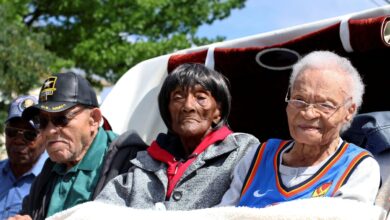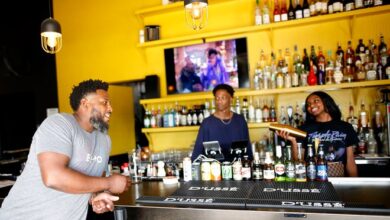Origins of Black Wall Street

The following is an excerpt from Black Fortunes: The Story of the First Six African Americans Who Escaped Slavery and Became Millionaires, by Shomari Wills, which details the origins of Black Wall Street.
Ottawa W. Gurley (aka O.W.) was a turn-of-the-20th-century Black educator, entrepreneur, and landowner who was born to former enslaved Africans. In 1889, after resigning from a position he held with the Grover Cleveland presidential administration, O.W. moved from his home state of Arkansas to Perry, Okla., in order to participate in the Oklahoma Land Grab of 1889. With his wife Emma, he later relocated to Tulsa to seize economic opportunities resulting from the city’s multiracial population boom. Once there, O.W. purchased a 40-acre tract of undeveloped land, where he built a grocery store on a dirt road that ran just north of the train tracks traversing the city.
O.W. later forged a partnership with fellow Black businessman John the Baptist Stradford (aka J.B.), with whom he shared a general distrust of White people. Both men chose to go by their initials instead of their first names. This action was a form of silent protest because men in the South were customarily addressed by their surnames, while boys were called by their first names. Sadly, White men often addressed Black men by their first names as a form of emasculation. By using their initials, O.W. and J.B. circumvented this practice.
O.W. and J.B. occasionally held divergent opinions. For example, while O.W. subscribed to the philosophies of African American educator Booker T. Washington, J.B. favored the more radical views of civil rights activist W. E. B. Du Bois. Despite their differences, the pair worked in lockstep to develop an all-Black district in Tulsa. They subdivided the land into housing zones, retail lots, alleys, and streets, all of which were exclusively available to other African Americans who were fleeing lynchings and other racial horrors.
Key Takeaways
- Ottawa W. Gurley was a Black educator, entrepreneur, and landowner who was born to former enslaved Africans.
- At the beginning of the 20th century, he bought 40 acres of land in Tulsa, Okla.
- Gurley forged a partnership with Black businessman John the Baptist Stradford, and the two developed an all-Black district in Tulsa, which became known as Greenwood.
- When hundreds of African Americans moved to Greenwood for the oil boom, the two became increasingly wealthy.
- Greenwood’s prosperity became legendary in Black America, with Booker T. Washington dubbing it “Black Wall Street.”
The Origin of Greenwood
After O.W. built several square two-story brick boardinghouses near his grocery store, he called the street on which these structures sat Greenwood Avenue, after the Mississippi town from which many of his early residents hailed. Before long, the entire area became known as Greenwood, which soon became the site for a school, as well as an African Methodist Episcopal Church. But O.W.’s crowning project was the Gurley Hotel, whose high quality rivaled that of the finest White hotels in the state.
As hundreds of African Americans emigrated to Greenwood for the oil boom, O.W. and J.B. became increasingly wealthy, with O.W. boasting a reported net worth of $150,000 ($3.6 million adjusted for inflation). O.W. leveraged this fortune to launch a Black Masonic lodge and an employment agency while bankrolling efforts to resist Black voter suppression in the state.
Pushback Within the African American Community
O.W. was eventually appointed as a sheriff’s deputy by the city of Tulsa, where he was responsible for policing the Black population in Greenwood. But as O.W. became increasingly cozy with the White establishment, many members of Tulsa’s Black community began to resent him. In fact, in the Black Star newspaper, its militant Black publisher A.J. Smitherman pejoratively referred to O.W. as “The King of Little Africa.”
Nevertheless, White developers began to emulate O.W. and J.B. by purchasing plots of land located north of the railroad tracks and selling them back to members of the Black community. By 1905, a Black doctor and a Black dentist had launched practices there. The creation of more schools, several hardware stores, and a Baptist church soon followed. Throughout this time, segregation was increasing, as Blacks converged on the north side of the train tracks, while Whites converged on the south side.
When the Oklahoma territory achieved statehood in 1907, segregationist Democrats, led by the White supremacist Bill “Alfalfa” Murray, passed laws that criminalized interracial marriage and prohibited Blacks from obtaining high-wage jobs. These injustices affirmed O.W. and J.B.’s decision to establish a Black-centric community, where Black men and women were shielded from racial hostilities. If White people made threateningly racist remarks, Greenwood’s Black residents often responded aggressively. For example, in 1909, J.B. was walking along Greenwood Avenue when a White deliveryman uttered a racist insult, prompting J.B. to throw the man to the ground, straddle him, and punch his face until it was bloody. J.B. was criminally charged for the beating but was acquitted.
On a separate occasion, J.B. was kicked off a train in Oklahoma for sitting in the first-class car—even though he’d purchased a first-class ticket. When he was asked to move to the Black-only car, he refused to comply. He later filed a lawsuit in an effort to desegregate Tulsa’s trains but was unsuccessful.
Greenwood Prospers
As segregation grew stronger, Greenwood’s Black business district thrived, mainly because residents fed their purchasing dollars back into the local economy while earning their incomes from White employers. This was possible because the migration of oilmen to Tulsa created a spike in demand for domestic help, which enabled Black residents to attain high-paying labor jobs as maids, chauffeurs, gardeners, janitors, shoe shiners, and porters. These workers often earned enough money to send their children to universities like Columbia Law School, Oberlin College, the Hampton Institute, the Tuskegee Institute, Spelman College, and Atlanta University, which positioned them to secure white-collar jobs after graduation.
Greenwood’s prosperity became legendary in Black America, with Booker T. Washington dubbing it “Black Wall Street.”
What Did JB Stradford Do?
JB Stratford founded “Black Wall Street”, together with Ottawa W. Gurley in the early 20th century. Located in Tulsa, Oklahoma, hundreds of Black Americans moved to the thriving district during the oil boom, while the founders amassed greater fortunes.
What Was Black Wall Street Famous For?
Black Wall Street, located in the Greenwood neighbourhood in Tulsa, Oklahoma was one of America’s most prosperous business districts in the early 20th century. The district became an economic powerhouse, with independent schools, banks, hotels, and transit systems.
Who Bought the Land for Black Wall Street?
O.W. Gurley purchased 40 acres of land in 1906 in the Greenwood District of Tulsa, Oklahoma. During that time, Black ownership of land was unheard of. As the business district expanded and thrived, Gurley grew to own 100 of the 600 businesses in operation.
The Bottom Line
Black Wall Street became an enclave for Black entrepreneurs and a gateway for economic prosperity. As a self-sustaining district, it became a beacon of wealth for business owners, while establishing independent school systems and public services. At the time, several millionaires emerged out of the thriving metropolis.
Through 1910 to 1920, the population of the Greenwood district almost quadrupled to 72,000, spanning to 35 city blocks. Thanks to the vision and partnership of founders O.W. Gurley and JB Stradford, the boomtown of Black Wall Street became the nation’s most prosperous hub during the early 20th century.
Copyright © 2018 by Shomari Wills. Reprinted by permission of Amistad, an imprint of HarperCollins Publishers.
























































